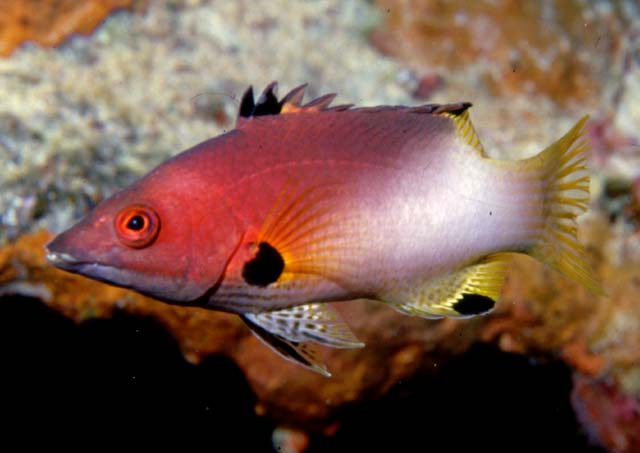| Labridae (Wrasses), subfamily: Bodianinae |
| 20 cm SL (male/unsexed) |
|
reef-associated; marine; depth range 2 - 100 m |
| Indo-Pacific: Red Sea to South Africa (Ref. 35918), east to the Marshall, Marquesan and Tuamoto islands, north to Japan (Ref. 559). |
|
Dorsal spines (total): 12-12; Dorsal soft rays (total): 9-10; Anal spines: 3-3; Anal soft rays: 12-13. Juveniles and females easily recognized by the generally black body with large white spots; males have large black spots on the soft parts of the dorsal and anal fins (Ref. 48636). Juveniles resemble the juveniles of B. mesothorax but have white rather than yellow spots. Undergoes a dramatic color change with growth. |
| Adults inhabit clear lagoon and seaward reefs (Ref. 1602); common in clear shallow waters at 1-8 m; large individuals occasionally at greater depths below 27 m (Ref. 75973). Juveniles occur solitary in caves or under ledges and act as cleaners by picking at bodies of other fishes (adults occasionally do this) (Ref. 1602); occurring regularly at depths of 14-26 m (Ref. 75973). Feed mainly on benthic, hard-shelled, invertebrates such as mollusks and crustaceans (Ref. 9823). Oviparous, distinct pairing during breeding (Ref. 205). Not commonly marketed. Occasionally seen in the aquarium trade. |
|
Least Concern (LC); Date assessed: 12 March 2008 Ref. (130435)
|
| harmless |
|
Also Ref. 4907, 81699. |
Source and more info: www.fishbase.org. For personal, classroom, and other internal use only. Not for publication.

